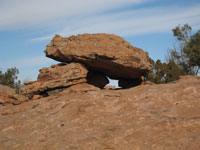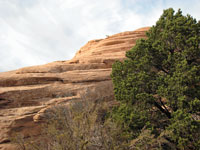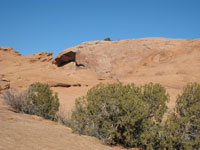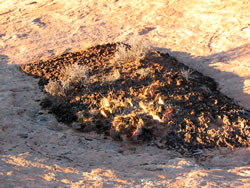HIKING HAPPENINGS January 2010
Fins and Things – The Big Picture
by Marcy Hafner
 From near and far mountain bikers and jeepers flock to the renowned Sand Flats Recreation Area (SFRA). Famous for the Slickrock and Porcupine Rim bike routes and almost 40 miles of jeep trails, this backyard gem is a mere ten-minute drive from downtown Moab. The hiking opportunities, however, especially in the quietude of winter, shouldn’t be overlooked. I come here often to enjoy the outstanding, unrestricted big picture - the stunning full circle horizontal panorama of Arches National Park, Behind the Rocks, Porcupine Rim and the La Sal Mountains - a wide screen portrait of striking high alpine peaks against the red rock desert below. From near and far mountain bikers and jeepers flock to the renowned Sand Flats Recreation Area (SFRA). Famous for the Slickrock and Porcupine Rim bike routes and almost 40 miles of jeep trails, this backyard gem is a mere ten-minute drive from downtown Moab. The hiking opportunities, however, especially in the quietude of winter, shouldn’t be overlooked. I come here often to enjoy the outstanding, unrestricted big picture - the stunning full circle horizontal panorama of Arches National Park, Behind the Rocks, Porcupine Rim and the La Sal Mountains - a wide screen portrait of striking high alpine peaks against the red rock desert below.
Sand Flats sits on exposed layers of sedimentary rock that include the Navajo and Kayenta Formations. During the Jurassic period, way back 150 million years ago, it’s mind-boggling to realize that the Colorado Plateau was situated near the equator in a dry, hot, empty land of shifting sand. Over the eons these prevailing sands petrified into Navajo sandstone, leaving behind the rounded slickrock that is so characteristic of what we see today throughout much of this territory. As the sand dunes drifted with the whims of the wind, they etched into the Navajo Sandstone a series of mystifying diagonal lines called “cross-bedding” leaving behind a signature trademark of their existence.
Bordered by two wilderness study areas - Negro Bill to the north, Mill Creek to the south - this unique playground receives almost 100,000 visitors a year. In response to the recreational overload, the Moab community, Americorps, Grand County and the Bureau of Land Management (BLM) collaborated in 1995 with the intent of preserving this precious resource. This coalition precipitated an unusual partnership between the county and the BLM so they could manage, protect, maintain and rehabilitate the over- used, exhausted land. In order to meet these goals, it became necessary to charge entrance and camping fees. Water is not available here and in the heat of the summer, you need to bring a truckload.
 To get to this outstanding recreational area, go south on Main Street and take a left at the Moab Information Center on to Center Street. At the stop sign on 400 East, go right. Then drive five blocks and turn left at Dave’s Corner Market on to Mill Creek Drive. At the three-way stop, go straight for the drive up the steep, winding Sand Flats Road to the entrance booth. To get to this outstanding recreational area, go south on Main Street and take a left at the Moab Information Center on to Center Street. At the stop sign on 400 East, go right. Then drive five blocks and turn left at Dave’s Corner Market on to Mill Creek Drive. At the three-way stop, go straight for the drive up the steep, winding Sand Flats Road to the entrance booth.
The entirety of the Fins and Things jeep trail is 9.4 miles, but since it parallels the Sand Flats Road, you can enter and exit at various intervals for a much shorter hike. I’m particularly fond of an easy-going segment that starts at the highly visible radio tower, which is also a good beacon while on the trail. One mile beyond the pavement a Fins and Things sign directs you on to the tower road, where there is available parking at two pullouts. From the lower spot, you’ll have to negotiate walking over the cattle guard.
A rough jeep trail, which steadily switches back and forth from sand to slickrock, drops sharply down from the tower. The route I’ve chosen is marked by painted white dots that quickly change to white dinosaurs. At the first signed fork, I hang a left to stay on the Fins and Things; a right leads back to the Sand Flats Road. Soon an arrow points toward a detour around a steep slickrock embankment that is blackened with rubber. Sometime after that the trail gradually sweeps in a westerly direction, with a brief, far off glimpse of The Three Gossips in Arches National Park. I don’t know why this vision intrigues me so much, but recognizing this well-known landmark from way off yonder is an extraordinary experience. Soon after that sighting, I am on the edge of a cliff with a spiraling look down into Negro Bill Canyon. Eventually the trail jogs a hard right, and I wander out on a long fin before approaching another sign – exit left for the Sand Flats Road (half-mile away) or go right to continue hoofing along on the rest of the trail.
The many sandstone rock formations trigger my imagination. A flat-topped rock looks like a perfect table all set for a party to show up for lunch. Two rock lizards meet snout to snout in an endless embrace. A gigantic protruding pinnacle thrusts its heavy bulk to the south sky, while a heavily fortressed castle guards the northern horizon.
 Sand Flats lies within the Pinyon-Juniper Belt, and the green foliage of the scattered pinyon pines and Utah junipers adds a dash of pizzazz to the soft brown landscape. The more subdued vegetation of Mormon tea, scrub oak, saltbush and rabbitbrush spreads out before me as I walk my course. Sand Flats lies within the Pinyon-Juniper Belt, and the green foliage of the scattered pinyon pines and Utah junipers adds a dash of pizzazz to the soft brown landscape. The more subdued vegetation of Mormon tea, scrub oak, saltbush and rabbitbrush spreads out before me as I walk my course.
Time for a break, and on this partly cloudy wintry day, I choose the radiating warmth of a slickrock backrest that offers the best angle to witness in the distance the entire profile of the La Sals, skimpily clad in snow. As I look around at my closer surroundings, I sense that this is the perfect habitat for the Ord’s kangaroo rat. It has sandy soil for its burrows and blackbrush, which produces seeds that are a staple food of this rodent’s diet.
Blackbrush, a spindly, lackluster shrub, received its name from the dark gray color of the bark, which blackens with age. On a wet day it appears even darker, creating a somber melancholic atmosphere. Don’t be fooled by its diminutive height. This hardy slow growing plant can live well over 100 years. Getting a start on life, however, is a finicky business because the seed producing yellow flowers only bloom when spring rains are unusually early and prolific.
The kangaroo rat population swings wildly in accordance with that food supply. These animals, whose life span is brief, like that of other rodents, maintain their numbers with a high rate of reproduction. Solitary and strongly territorial, they communicate by drumming with their hind feet.
These seed gatherers transport their load in two cheek pouches to their burrows for later consumption. Their ability to extract moisture from their diet of dry seeds enables them to survive without drinking water, a distinct advantage in the parched desert.
Sightings of these nocturnal beasts during the day are rare but I’ve been very lucky on several occasions to actually observe these adorable creatures in broad daylight as they hopped like kangaroos on their strong hind legs. A long tail ending in a blackish brush completes the look-alike kangaroo costume. Even though they are seldom seen, it is reassuring to know that they are probably sleeping underground in their cozy burrows.
By mid-afternoon the sun plays peek-a-boo with ever-thickening clouds. After awhile it disappears completely –a chilly signal clearly suggesting that the warmth of the day has departed and it is time to move along.
Overly crowded in the spring, Sand Flats is also wildly popular in the fall. It loses its appeal in the summer, though, when temperatures rise above the century mark, and hiking there becomes a recipe for a blazing workout in a land of minimal shade. The best strategy then is to go super early in the morning or during the cooling hours of dusk. For my money it is best in the winter when that short drive from the heart of Moab quickly transports me to an empty, easily accessible trail that features a dramatic big picture perspective that extends for miles and miles in all directions.
|
Biological Soil Crust (aka)
Cryptos (krip’ tose):
The surface of
Moab’s desert is held
together by a thin skin of living organisms known as cryptobiotic
soil or cryptos. It has a lumpy black appearance, is very
fragile, and takes decades to heal when it has been damaged.
This soil is a critical part of the survival of the desert.
The cryptobiotic organisms help to stabilize the soil, hold
moisture, and provide protection for germination of the seeds
of other plants. Without it the dry areas of the west would
be much different. Although some disturbance is normal and
helps the soil to capture moisture, excessive disturbance
by hooves, bicycle tires and hiking boots has been shown
to destroy the cryptobiotic organisms and their contribution
to the soil. When you walk around Moab avoid crushing the
cryptos. Stay on trails, walk in washes, hop from stone to
stone. Whatever it takes, don’t crunch the cryptos
unless you absolutely have to! |

Cryptobiotic soil garden
|
|
|